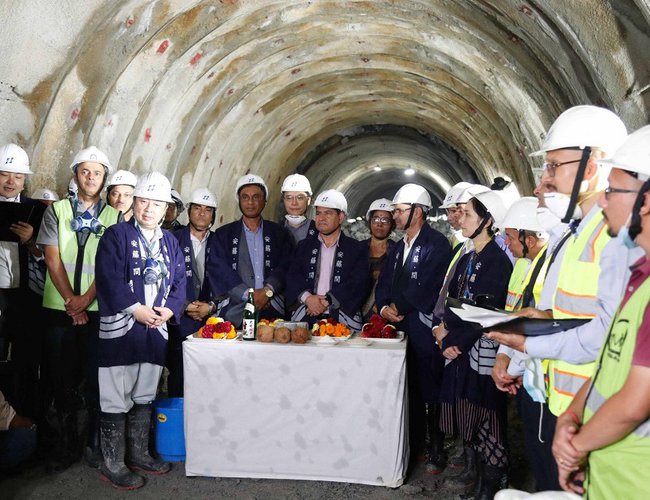
In the presence of Minister of Physical Infrastructure and Transport, Prakash Jwala, Ambassador of Japan to Nepal, Kikuta Yutaka, JICA head, other senior officials, technicians, and workers, a momentous occasion unfolded. With a single push of a button, the thin wall of the tunnel linking Sisne Khola of Dhading and Thankot was erased, and the rescue tunnel of Nagdhunga Tunnel was officially breakthrough.
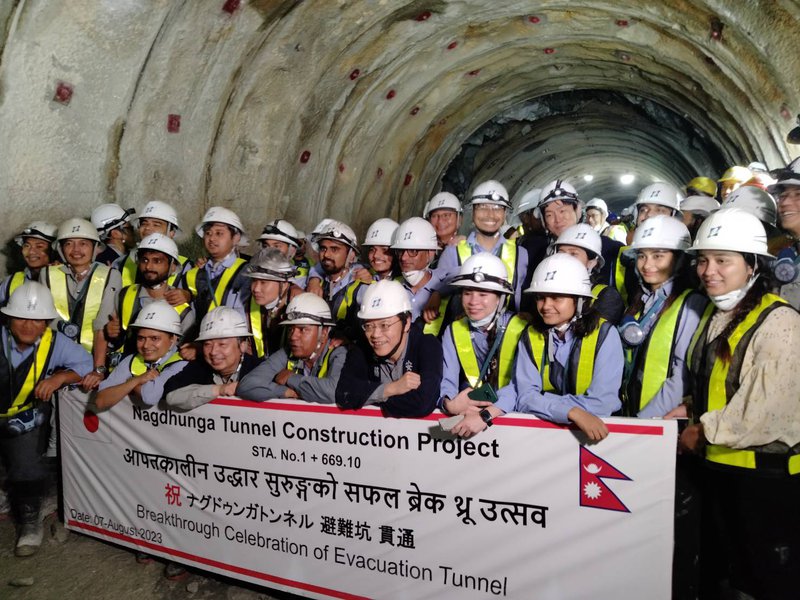
On (Monday, August 7), in accordance with Nepali and Japanese culture, the evacuation tunnel of the Nagdhunga-Sisnekhola tunnel, currently under construction, experienced a momentous breakthrough. The final blast was successfully executed, completing the 'breakthrough' of the rescue tunnel.
A special program was held to commemorate this significant event, taking place at both the route of the tunnel from Dhading (west) to its exit in Kathmandu (east).
The atmosphere instantly filled with joy and happiness as the people present at the ceremony celebrated this remarkable achievement. After relentless hard work to open the tunnel, there couldn't have been a more deserving moment to revel in the success.
The tireless work on the tunnel is progressing swiftly, and it is expected to be fully completed, enabling the smooth passage of vehicles, by September 2024. This state-of-the-art tunnel not only signifies a crucial infrastructure development but also stands as a symbol of the strong bilateral relations between Nepal and Japan.
The foundation stone for the tunnel was laid in October 2019, and since then, dedicated efforts have been invested in its construction. The tunnel spans an impressive length of 2.68 km and comprises two sections: the main tunnel, which is 9 meters wide, and the rescue tunnel, measuring 4 meters in width. This modern infrastructure project is a testament to the strong collaboration between Nepal and Japan, symbolizing their commitment to progress and connectivity.
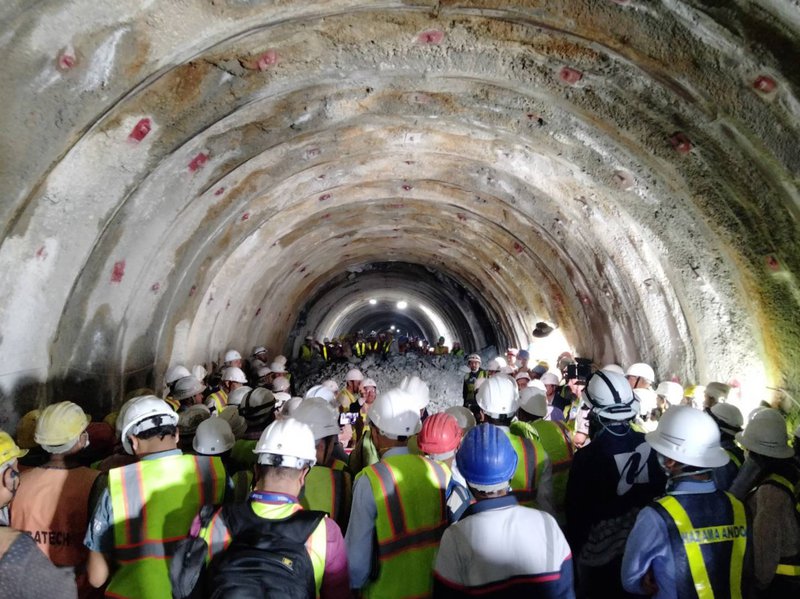
The completion of the evacuation tunnel marks a major milestone in the Nagdhunga-Sisnekhola tunnel project, and it is expected to significantly improve transportation and accessibility in the region. This achievement represents a remarkable feat of engineering and underscores the mutual efforts of both nations to enhance their ties and foster development.
Once operational, the Nagdhunga tunnel will alleviate traffic congestion, reduce travel time, and enhance the overall transportation experience for both local commuters and tourists. The project's successful completion will undoubtedly bring about positive impacts on Nepal's economy and tourism sector.
With the tunnel poised to become a game-changer for Nepal's transportation network, the anticipation and excitement among the Nepalese population are growing. It is expected to open up new opportunities for trade, commerce, and tourism, fostering prosperity and connectivity in the region.
As the project nears its final stages, authorities from both Nepal and Japan are continuing to collaborate closely to ensure all necessary safety standards and quality measures are met.
The dedication and support from the Japanese government in this endeavor have strengthened the ties between the two nations and showcased Japan's commitment to contributing to Nepal's development.
Minister Jwala’s Remark
Minister of Physical Infrastructure, Jwala, enthusiastically declared this day as a historic milestone with the opening of Nepal's first modern tunnel road. He expressed optimism that the tunnel will be completed by the next year, enabling smooth vehicular movement.
In his speech, Minister Jwala extended heartfelt gratitude to the government of Japan for their invaluable assistance in building crucial infrastructures in Nepal. He emphasized that Japan's contributions to Nepal's development sector have been immense, highlighting the support received during the earthquake reconstruction.
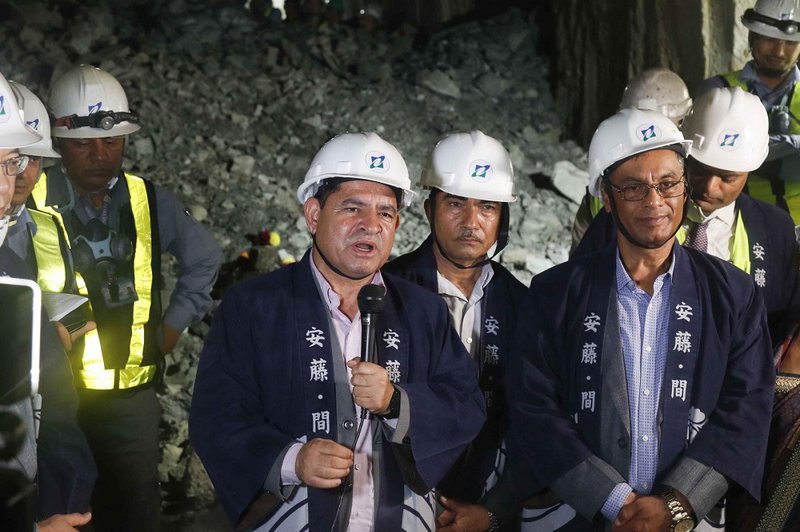
During the ceremony, Minister Jwala also conveyed special appreciation to the Government of Japan and JICA for their unwavering support in constructing this landmark project. He firmly believed that this breakthrough infrastructure would significantly enhance the trading of goods through improved vehicular movement, thus fostering prosperity in the country's economic conditions.
The completion of this tunnel stands as a testament to the strong bilateral relations between Nepal and Japan, and it reflects the fruitful collaboration in bringing essential infrastructure projects to fruition. Minister Jwala's words conveyed a sense of optimism and determination to continue fostering positive relationships and advancements in Nepal's development journey.
Minister Jwala provided clear directives to the construction company, emphasizing the importance of completing the tunnel route within the extended deadline.
He assured the government's support in overcoming any practical complexities that may arise during the construction process. Additionally, Minister Jwala personally inquired about the progress and condition of the tunnel route to stay informed about the developments.
Ambassador Kikuta
For Japanese ambassador to Nepal Kikuta, the attending the breakthrough ceremony is second major events following the wrapping up major school reconstruction project. All the 274 school buildings, which were destroyed by earthquake in 2015, are reconstructed with multi-hazard resilient structures which are child, gender and disable friendly to provide improved learning environment for the students based on the concept of BBB which increases resilience not only physically but also socially.
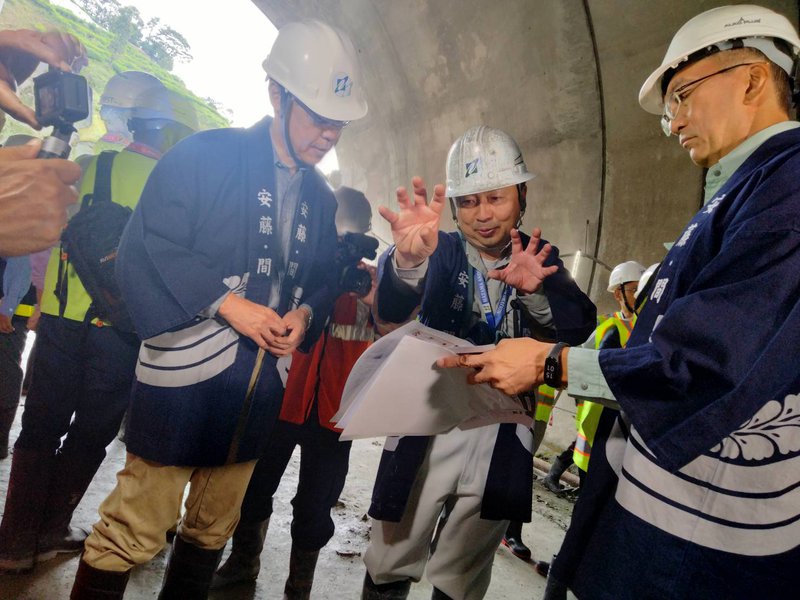
Ambassador of Japan to Nepal Kikuta congratulated all the stakeholders, both Japanese and Nepali sides, for coming so far in spite of so many obstacles and wished them the best of luck for a smooth completion of the remaining work.
He has also emphasized the importance of ensuring proper safety measures in the construction site. Nepal is a mountainous country like Japan. Thus, tunnels would take an indispensable part in the transport sector in Nepal. Japan has a highly developed tunnel construction technology and rich experiences.
Modern Project
Being the first-ever modern high tech road tunnel construction in Nepal with technology transfer from Japan, this project holds immense significance. Its successful implementation not only promises to improve the traffic situation at the construction site but also paves the way for future advancements in Nepal's transportation sector.
Monitoring the progress, Secretary at the Ministry of Physical Infrastructure and Transport, Keshav Kumar Sharma, is actively involved in the project. On a recent occasion, Minister Jwala conducted a thorough assessment of the tunnel works to gauge its status and progress.
Due to the unavoidable delays caused by the Covid-19 pandemic and other factors, the construction period of the tunnel has been extended by 14 months. As per the revised timeline, the entire project is expected to be completed, allowing vehicles to pass through the tunnel by September 2024.
"Today, Nepal embarks on a new phase of modern infrastructure development," expressed Secretary Keshav Sharma of the Ministry of Physical Infrastructure, recognizing the transformative impact of this groundbreaking project on the nation's infrastructure landscape. The collaboration with Japan in this endeavor marks a testament to the deepening ties between the two countries and reinforces the commitment towards progress and prosperity in Nepal.
According to Spokesperson Narayan Duwadi, the main tunnel still requires approximately 500 meters to be dug, while the rescue tunnel lacks around 35 meters of completion. In response, construction activities have been significantly accelerated to ensure that vehicles can operate along the tunnel route by the next year. It is noteworthy that the foundation stone for this 2.68-kilometer tunnel route was laid around four years ago.
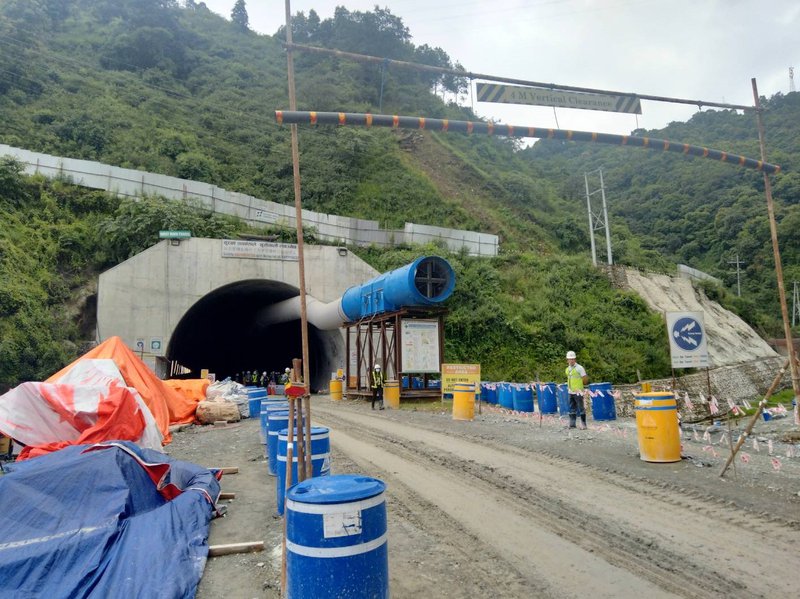
Duwadi, spokesperson for the Nagadhunga-Sisnekhola tunnel project, shared that out of the total 2,557 meters, an impressive 2,556 meters of digging work has already been completed. This indicates that the tunneling work of the project is at an advanced stage, with 91 percent completion. Furthermore, the overall physical progress of the project stands at an encouraging 80 percent.
“The project's steady advancement highlights the collective efforts and commitment to achieving this significant infrastructure development, which is set to revolutionize transportation in Nepal. The diligent work of all involved stakeholders brings the dream of a modern, efficient tunnel route closer to becoming a reality,” said Duwadi.
Nagdhunga Tunnel
The Nagdhunga Tunnel, funded with the support of the Japanese government, marks a significant milestone in Nepal's modern infrastructure development.
As the first modern highway tunnel designed to accommodate larger vehicles, it is set to bring about transformative changes in road construction within the country.
While Nepal had constructed 500 meter long first road tunnel in the Churia region in 1917, the Nagdhunga Tunnel stands out as the longest and most advanced of its kind in the nation.
After the construction of first Churia tunnel under a leadership of Nepali engineer Colonel Dilli Jung Thapa, Nepal entered in tunnel technology. However, it took almost another 106 years to complete the modern tunnel in Nepal.
Nepalese Are learning
According to project head Naveenman Shrestha, our technicians are also learnt from Japanese technology. This is the first modern high quality tunnel in Nepal. Nepali Construction Company is constructing the tunnel using Nepali workers. This is the main part of the JICA ODA loan support to Nepal.
This means Nepalese contractor company, engineers and other technician will learn the tunnel road in Nepal. This is first of its kind contributing to the local socio economic development ending the traffic congestion at the entry point of Kathmandu.
Earlier, the Japanese government had provided grant assistance to build the 158 km BP Highway, also known as Banepa-Bardibas Highway and Koteshwor-Suryabinayak road section.
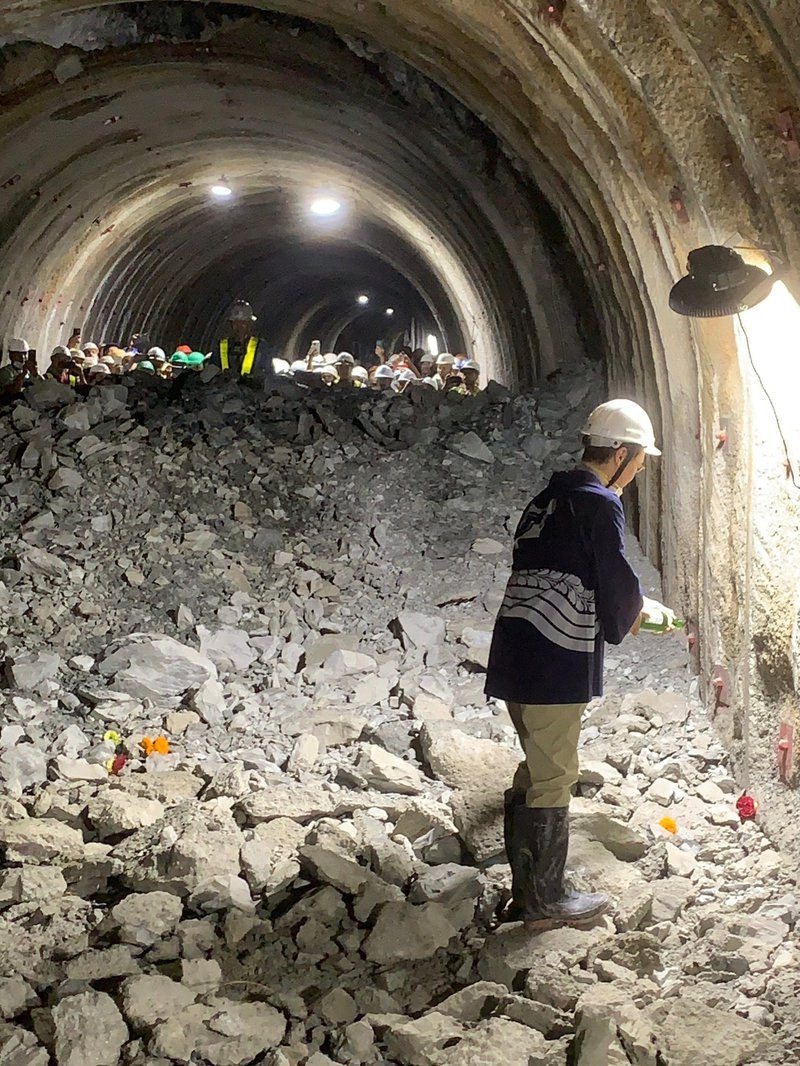
A joint venture (JV) of Nippon Koei, Eight Japan Engineering Consultants, and Nippon Civic Consulting Engineer in association with GEOCE Consultants, and ITECO-NEPAL is consulting the construction project while Hazama Ando Corporation, a Japanese construction company is contracted for the construction purpose which was also contracted to build the Banepa-Bardibas Highway and Koteshwor-Suryabinayak road section.
First Modern Tunnel
Funded by the Government of Japan through JICA and the Nepal government, the project's total cost amounts to Rs 22.14 billion, with the Nepalese government contributing Rs 5.85 billion and JICA lending the remaining Rs 16.5 billion (equivalent to JPY 16.636 billion) under ODA.
This low-interest loan assistance, provided at a rate of 0.01% for 40 years, including a 10-year grace period without interest or installments, showcases Japan's commitment to supporting the development of Low-Income Least Developed Countries like Nepal.
Construction of the tunnel began in October 2019 with a planned construction period of 42 months. However, due to unforeseen challenges, such as the COVID-19 pandemic, the project completion date has been extended to April 25, 2024.
The tunnel spans a total length of 2.68 kilometers and consists of two lanes, each with a width of 3.5 meters, a median width of 1.5 meters at the center, and 0.5-meter-wide spaces on both sides for drainage facilities.
Notably, the tunnel will be equipped with 24-hour ventilation (Jet fan) and lighting systems, ensuring safe and efficient passage for commuters and cargo vehicles. Additionally, an evacuation tunnel, stretching 2.55 kilometers, has been incorporated for emergency services. The project has made significant progress, with approximately 49 percent of the physical work already completed.

As the tunnel offers a modern, high-quality infrastructure, Nepalese engineers have had the opportunity to learn essential skills from Japanese technology, enhancing their expertise for future development projects.
The Nagdhunga Tunnel Construction Project is a testament to the enduring partnership between Nepal and Japan, exemplified by Japan's contribution to several strategically significant infrastructure projects in Nepal, ranging from hydropower and drinking water to health, aviation, education, disaster management, and road development.
By sharing its modern tunnel technology with Nepal, Japan has further solidified its commitment to enhancing Nepal's infrastructure and promoting socio-economic progress within the country. With the successful completion of the Nagdhunga Tunnel, Nepal's transportation network is set to achieve new heights, fostering economic growth and prosperity for the nation.
Japan’s Support
Japan has been a steadfast supporter of Nepal's modernization process, offering financial and technical assistance for various infrastructure projects since the establishment of diplomatic relations between the two countries on 01 September 1956.
The scope of support from Japan ranges from essential infrastructure development to livelihood enhancement, encompassing diverse areas such as Trout Fishing in Junar, fish and rice improvement in Janakpur, and the highly acclaimed "one village, one product" initiative that has brought about significant changes in the agriculture sector.
It is worth noting that this is not the first model infrastructure project in Nepal to benefit from Japanese assistance. Thanks to the generous support from the Government of Japan, numerous strategically important infrastructure projects have already been successfully completed. These projects include hydropower ventures like Kulekhani, Kali Gandaki A, and the Tanahu Hydropower project, which play crucial roles in meeting the country's energy needs.
Additionally, Japan's aid has extended to areas such as electricity distribution improvement, modernizing the navigation system at Tribhuvan International Airport (TIA), drinking water facilities, healthcare advancements, aviation infrastructure, educational initiatives, and disaster management and road sector development.
The long-standing partnership between Nepal and Japan has played a pivotal role in fostering progress and development across various sectors in Nepal, leaving a positive and lasting impact on the nation's growth and prosperity. The collaborative efforts have not only enriched infrastructural capabilities but have also uplifted livelihoods and strengthened the foundation for a promising future.
Japan has provided much needed technical and financial support to Nepal in its all major infrastructures projects including electricity, drinking water, road, health, education, town planning and agriculture.
Building the first storage Kulekhani Hydropower project almost 38 years ago, Japan contributed immensely to stabilize Nepal’s power supply system, providing the livelihood improvement for local community promoting fishing.
JICA supported to build water treatment plant of Melamchi project and TUTH Hospital is another example where hundreds of Nepalese learnt medical education and tens of thousands Nepalese have been getting medical benefits from it.
Japan’s recent support constructing new modern building for Bir Hospital has already enhanced the capacity.
The breakthrough of the rescue tunnel of Nagdhunga Tunnel marks a significant milestone and symbolizes a new beginning for Nepal's infrastructure development. It underscores the continued importance and relevancy of Japanese support in driving Nepal's progress and growth. Once again, Japan's steadfast assistance has played a pivotal role in shaping the development landscape of Nepal, paving the way for a brighter and more promising future.

Keshab Poudel
Poudel is the editor of New Spotlight Magazine.
- HELVETAS NEPAL’S RIVERBED FARMING: Shift From Overseas To Local Farming
- Jul 26, 2024
- POLITICAL SCENARIO : K.P. Sharma Oli's Resurgence
- Jul 21, 2024
- UNDP/MinErgy: An Inventive Approach To Clean Brick Kiln
- Jul 19, 2024
- HELVETAS NEPAL: Nutrition Through Riverbed Farming
- Jul 18, 2024
- NOU Opens To All: Dr. Shilu Manandhar Bajracharya, Vice Chancellor
- Jul 15, 2024
















